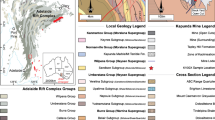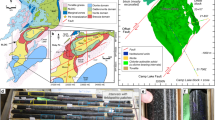Abstract
Supergene jarosite-group minerals are widespread in weathering profiles overlying Pb-Zn sulfide ores at Xitieshan, northern Tibetan Plateau, China. They consist predominantly of K-deficient natrojarosite, with lesser amounts of K-rich natrojarosite and plumbojarosite. Electron microprobe (EMP) analyses, scanning electron microcopy (SEM) investigation, and X-ray mapping reveal that the jarosite-group minerals are characterized by spectacular oscillatory zoning composed of alternating growth bands of K-deficient and K-bearing natrojarosite (K2O >1 wt.%). Plumbojarosite, whenever present, occurs as an overgrowth in the outermost bands, and its composition can be best represented by K0.29Na0.19Pb0.31Fe2.66Al0.22(SO4)1.65(PO4)0.31(AsO4)0.04(OH)7.37. The substitution of monovalent for divalent cations at the A site of plumbojarosite is charge balanced by the substitution of five-valent for six-valent anions in XO4 at the X site. Thermogravimetric analysis (TGA) of representative samples reveal mass losses of 11.46 wt.% at 446.6 °C and 21.42 wt.% at 683.4 °C due to dehydroxylation and desulfidation, respectively. TGA data also indicate that the natrojarosite structure collapses at 446.6 °C, resulting in the formation of NaFe(SO4)2 and minor hematite. The decomposition products of NaFe(SO4)2 are hematite and Na2SO4. Powder X-ray diffraction (XRD) analyses show that the jarosite-group minerals have mean unit-cell parameters of a = 7.315 Å and c = 016.598 Å. XRD and EMP data support the view that substitutions of Na for K in the A site and full Fe occupancy in the B site can considerably decrease the unit-cell parameter c, but only slightly increase a. The results from this study suggest that the observed oscillatory zoning of jarosite-group minerals at Xitieshan resulted mainly from substitutions of K for Na at the A site and P for S at the X site.









Similar content being viewed by others
References
Alpers CN, Brimhall GH (1989) Paleohydrological evolution and geochemical dynamics of cumulative supergene metal enrichment at La-Escondida, Atacama Desert, northern Chile. Econ Geol 84:229–255
Alpers CN, Nordstrom DK, Ball JW (1989) Solubilit ofjarosite solid solutions precipitated from acid mine waters, Iron Mountain, California, U.S.A. Sci Geol Bull 42:281–298
Alpers CN, Rye RO, Nordstrom DK, White LD, King BS (1992) Chemical, crystallographic and stable isotopic properties of alunite and jarosite from acid hypersaline Australian lakes. Chem Geol 96:203–226
Basciano LC, Peterson RC (2007) Jarosite-hydronium jarosite solid-solution series with full iron site occupancy: mineralogy and crystal chemistry. Am Mineral 92:1464–1473
Basciano LC, Peterson RC (2008) Crystal chemistry of the natrojarosite-jarosite and natrojarosite-hydronium jarosite solid-solution series: a synthetic study with full Fe site occupancy. Am Mineral 93:853–862
Basciano LC, Peterson RC (2010) A crystallographic study of the incomplete solid-solution between plumbojarosite and jarosite. Can Mineral 48:651–659
Brophy GP, Sheridan MF (1965) Sulfate studies IV: the jarosite-natrojarosite-hydronium jarosite solid solution series. Am Mineral 50:1595–1607
Burger PV, Papike JJ, Shearer CK, Karner JM (2009) Jarosite growth zoning as a recorder of fluid evolution. Geochim Cosmochim Acta 73:3248–3259
Desborough GA, Smith KS, Lowers HA, Swayze GA, Hammarstrom JM, Diehl SF, Leinz RW, Driscoll RL (2010) Mineralogical and chemical characteristics of some natural jarosites. Geochim Cosmochim Acta 74:1041–1056
Drouet C, Baron D, Navrotsky A (2003) On the thermochemistry of the solid solution between jarosite and its chromate analog. Am Mineral 88:1949–1954
Drouet C, Pass KL, Baron D, Draucker S, Navrotsky A (2004) Thermochemistry of jarosite-alunite and natrojarosite-natroalunite solid solutions. Geochim Cosmochim Acta 68:2197–2205
Dutrizac JE (1983) Factors affecting alkali jarosite precipitation. Metall Mater Trans B 14:531–539
Dutrizac JE, Jambor JL (2000) Jarosites and their application in hydrometallurgy. Sulfate minerals–crystallography, geochemistry and environmental significance. Rev Mineral Geochem 38:405–452
Dutrizac JE, Kaiman S (1976) Synthesis and properties of jarosite-type compounds. Can Mineral 14:151–158
Graham SA, Chamberlain CP, Yue YJ, Ritts BD, Hanson AD, Horton TW, Waldbrauer JR, Poage MA, Feng X (2005) Stable isotope records of Cenozoic climate and topography, Tibetan Plateau and Tarim Basin. Am J Sci 305:101–118
Grohol D, Nocera DG (2002) Hydrothermal oxidation-reduction methods for the preparation of pure and single crystalline alunites: synthesis and characterization of a new series of vanadium jarosites. J Am Chem Soc 124:2640–2646
Grohol D, Nocera DG, Papoutsakis D (2003) Magnetism of pure iron jarosites. Phys Rev B 67:064401
Hendricks SB (1937) The crystal structure of alunite and the jarosites. Am Mineral 22:773
Jambor JL (1999) Nomenclature of the alunite supergroup. Can Mineral 37:1323–1341
Jambor JL, Dutrizac JE (1983) Beaverite-plumbojarosite solid solutions. Can Mineral 21:101–113
Jamieson HE, Robinson C, Alpers CN, Nordstrom DK, Poustovetov A, Lowers HA (2005) The composition of coexisting jarosite-group minerals and water from the Richmond mine, Iron Mountain, California. Can Mineral 43:1225–1242
Kubisz J (1970) Studies on synthetic alkali-hydronium jarosites. I: synthesis of jarosite and natrojarosite. Mineralogia 1:47–57
Lai SC, Deng JF, Zhao HL (1996) Paleozoic ophiolites and its tectonic significance on north margin of Qaidam basin. Geoscience 10:18–28, in Chinese with English abstract
Majzlan J, Stevens R, Boerio-Goates J, Woodfield BF, Navrotsky A, Burns PC, Crawford MK, Amos TG (2004) Thermodynamic properties, low-temperature heat-capacity anomalies, and single-crystal X-ray refinement of hydronium jarosite, (H3O)Fe3(SO4)2(OH)6. Phys Chem Miner 31:518–531
Nielsen UG, Majzlan J, Phillips B, Ziliox M, Grey CP (2007) Characterization of defects and the local structure in natural and synthetic alunite (K, Na, H3O)Al3(SO4)2(OH)6 by multi-nuclear solid-state NMR spectroscopy. Am Mineral 92:587–597
Oliveira SMB, Blot A, Imbernon RAL, Magat P (1996) Jarosita e plumbojarosita nos gossans do distrito mineiro de Canoas (PR). Rev Bras Geocienc 26:3–12
Papike JJ, Burger PV, Karner JM, Shearer CK, Lueth VW (2007) Terrestrial analogs of martian jarosites: major, minor element systematics and Na-K zoning in selected samples. Am Mineral 92:444–447
Parkhurst DL, Appelo CAJ (2000) User’s guide to PHREEQC (version 2)-a computer program for speciation, batch-reaction, one-dimensional transport, and inverse geochemical calculations. USGS Water-Resources Invest Rep, pp 99–4259
Ripmeester JA, Ratcliffe CI, Dutrizac JE, Jambor JL (1986) Hydronium ion in the alunite–jarosite group. Can Mineral 24:435–447
Rye RO, Alpers CN (1997) The stable isotope geochemistry of jarosite. U.S. Geol Surv Open-File Rep, pp 88–97
Rye RO, Bethke PM, Lanphere MA, Steven TA, Anonymous (1993) Age and stable isotope systematics of supergene alunite and jarosite from the Creede mining district, Colorado; implications for supergene processes and Neogene geomorphic evolution and climate of the Southern Rocky Mountains. Abstracts with Programs, 25:274
Savage KS, Bird DK, O'Day PA (2005) Arsenic speciation in synthetic jarosite. Chem Geol 215:473–498
Scott KM (1987) Solid-solution in, and classification of, gossan-derived members of the alunite-jarosite family, northwest Queensland, Australia. Am Mineral 72:178–187
Shannon R (1976) Revised effective ionic radii and systematic studies of interatomic distances in halides and chalcogenides. Acta Crystallogr A 32:751–767
Stoffregen RE, Alpers CN, Jambor JL (2000) Alunite-jarosite crystallography, thermodynamics, and geochronology. Sulfate minerals–crystallography, geochemistry and environmental significance. Rev Mineral Geochem 38:453–479
Szymański JT (1985) The crystal structure of plumbojarosite Pb[Fe3(SO4)2(OH)6]2. Can Mineral 23:659–668
Tu G, Li X (1963) Studies on the characteristic features of the oxidation zone of the sulphite deposits in arid to extremely arid regions (with special reference to observations obtained from five sulfide deposits in the northwestern China). Acta Geol Sin 43:362–376, in Chinese with English abstract
Wills AS, Harrison A (1996) Structure and magnetism of hydronium jarosite, a model Kagome antiferromagnet. J Chem Soc Faraday Trans 92:2161–2166
Wu J (1985) Geological characteristics of the Xitieshan massive sulfide deposit, Qinghai province. Miner Depos 4:1–12, in Chinese with English abstract
Yang JS, Xu ZQ, Zhang JX, Song SG, Wu CL, Shi RD, Li HB, Brunel M (2002) Early Palaeozoic North Qaidam UHP metamorphic belt on the north-eastern Tibetan plateau and a paired subduction model. Terra Nova 14:397–404
Zhao F, Guo J, Li H (2003) Geological characteristics and isotopic age of Tanjianshan Group along northern margin of Qaidam basin. Geol Bull China 22:28–31, in Chinese with English abstract
Zhu X, Deng J, Wang J, Lin L, Fan J (2006) Study of two types of ore bodies in Xitieshan lead-zinc SEDEX deposit, Qinghai Province. Mineral Deposits 25:252–262, in Chinese with English abstract
Acknowledgments
The financial supports of this study were provided by the Natural Science Foundation of China (grants 40573021, 40821061), the Fundamental Research Funds for the Central Universities (CUG120102), and the MOST special fund from the State Key Laboratory of Geological Processes and Mineral Resources (MSFGPMR201205). A major part of the analytical work of this study was done at the Denver Federal Center of USGS by the senior author during her USGS visit, which was partly supported by China University of Geosciences (Wuhan). Prof. Paul Robinson, Drs. Kathy Smith, Gregg Swayze and Ian Grey provided constructive reviews on an earlier draft of this paper. Thorough reviews by two anonymous referees and constructive suggestions by Associate Editor Anton Beran have been very helpful in improving the presentation of the paper, for which we are gratefully acknowledged. Our thanks extend to Xiao-Dong Deng for his help in preparation of the manuscript.
Author information
Authors and Affiliations
Corresponding author
Additional information
Editorial handling: A. Beran
Rights and permissions
About this article
Cite this article
Chen, L., Li, JW., Rye, R.O. et al. Mineralogical, chemical, and crystallographic properties of supergene jarosite-group minerals from the Xitieshan Pb-Zn sulfide deposit, northern Tibetan Plateau, China. Miner Petrol 107, 487–499 (2013). https://doi.org/10.1007/s00710-012-0258-y
Received:
Accepted:
Published:
Issue Date:
DOI: https://doi.org/10.1007/s00710-012-0258-y




